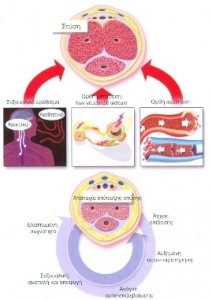Erectile Dysfunction – Introduction
The term erectile dysfunction mean prolonged weakness starting or maintaining an erection due to which is unsatisfactory or impossible sexual intercourse.
Normal sexual function includes five phases:
A. The sexual desire (libido)
This is determined by hormonal factors (functions of the hypothalamic-pituitary axis) of the hormones produced by the testis (androgenic) as well as the influence of mental – psychological factors.
B. The phase of erection
To understand and interpret the situations that lead to an erection, it seems appropriate knowledge of basic anatomy of the penis and the mechanism. Regarding the anatomy of the penis consists of 3 parts, the glans, the body (with the 2 corpora cavernosa and cancellous urethra) and the root of the penis, while on the erectile mechanism, when a man is sexually stimulate, induce relaxation of muscle fibers of the spiral arteries in the penis, which efthiazontai and increases the lumen. This leads to fill with blood, the cavernous sinus while the muscles of the region in a manner pushing the veins in order to be no escape of blood from them. In this way achieved enlarge the corpora cavernosa and finally erection.
stimulatez
1. Relaxation phase
Characterized by low blood flo, low intracavernous pressure and blood gases were same as those in venous blood
2. Filling phase
Characterized by relaxation of smooth muscle and increasing blood flow. The pressure in the corpora cavernosa remains normal (5-7 mmHg).
3. Expansion phase
Continue the relaxation of smooth muscle fibers with the pressure in the corpus to increase speed.
4. Stage full erection
The pressure in the corpus cavernosum is equal to the mean blood pressure.
5. Rigid erection phase
The pressure in the corpus cavernosum is greater than the mean blood pressure. This stage is very short.
C. The phase of ejaculation
It consists of two phases :
• The discharge phase of seminal fluid and
• The main ejaculation
At this point it should be emphasized that the above may occur independently of each other and this is because each depends on different neurophysiological mechanism.
D. The phase of orgasm, which is purely cerebral phenomenon
E. The phase resetting
After ejaculation, the penis gradually returns to phase relaxation
Related Articles





